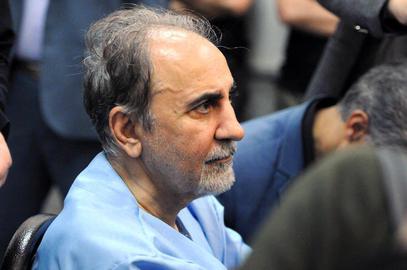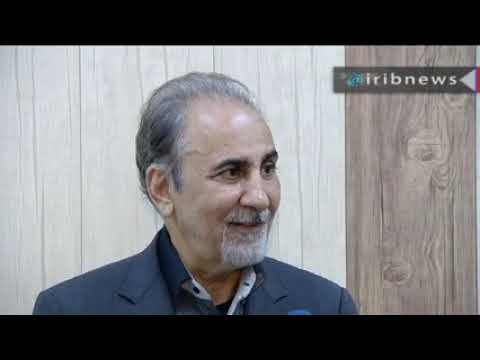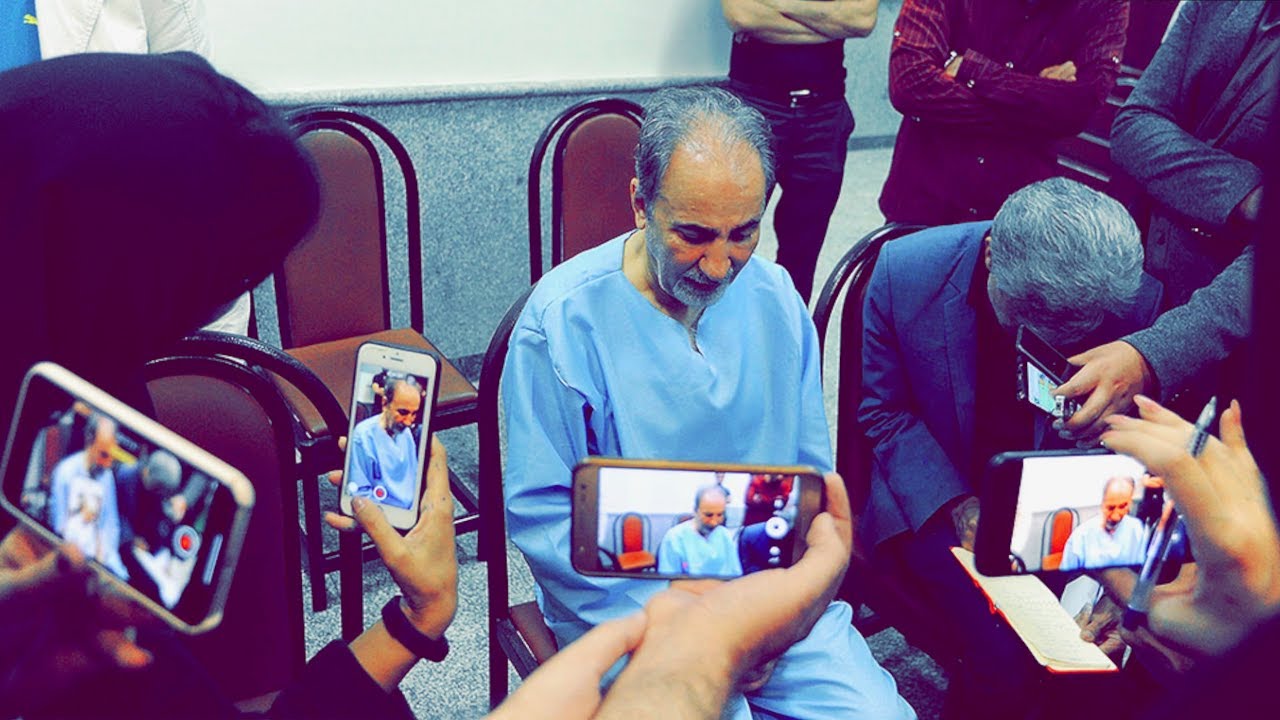At the Police Criminal Investigation Bureau at Tehran’s Islamic Unity Street, a man faces the camera and says that on Thursday at 7pm, Mr. Mohammad Ali Najafi presented himself to the authorities. Mohammad Ali Najafi himself sits behind the man, on the left side of the room, and follows the movements of the camera. As usual, he wears a suit. He looks straight at the camera for a fleeting moment and then puts what many now regard to be a controversial teacup on the table.
The announcer turns around and the viewer sees that there are three people in the room. He says the other two are Commander Alireza Lotfi, head of Tehran’s Criminal Investigation Bureau, and an expert from the bureau.
Since Wednesday, May 29, when the news broke that Mohammad Ali Najafi had murdered his wife Mitra Ostad, numerous videos of the veteran politician-turned-murderer have been posted and shared online — some of them show him in the same pressed suit in the video just described, others show him being interviewed in a prison uniform. The videos and news have triggered an avalanche of comments and reactions across social networks.
IRIB video taken at the Police Criminal Investigation Bureau
The video of Najafi drinking tea received a lot of attention, more than many other clips. Some on social media accused Iran’s justice system of discriminating between “insiders” and “outsiders.”
“Which law has told you to stand to attention before a confessed killer and bow to him?” one person on Twitter asked, his question directed at Commander Lotfi.
Bahram Golzadeh, a former reporter for the Islamic Republic News Agency (IRNA), described the bizarre series of events. “[Iranian] TV's stage setting for making the video, from the moment that Najafi enters the investigation bureau to [him] exchanging pleasantries [and] drinking tea, the conversation and the goodbyes, were unique in the history of radio and television.” Another commentator, Mohammad Reza Goodarzi, said it more succinctly: “He kills his wife and then they show him on video drinking tea.”
Najafi's confession that he murdered his wife
Another person on Twitter using the name Saeed contrasted the scene at the investigations bureau with the treatment of women who have been arrested for wearing their headscarves inappropriately. “This video was a marvel,” he wrote. “Tehran’s former mayor kills his wife with five bullets but then they give him tea at the station and bow to him respectfully. By the way, tell us how you treat someone who has been arrested for the crime of bad hijab?”
“Najafi went to the police station where he was received with respect,” wrote another observer called Farbod. “Then he was drinking tea in the office of the police chief. And my civics teacher drove me insane by shouting ‘everybody is equal before the law!’”
Tea and Sympathy for the Murderer
“In Iran it is better to be a crow than a woman,” posted someone called Kambuzia. If you are a woman, “they simply kill you and then treat your murderer with tea.”
On its Twitter page, the Turquoise Women of Iran, a women’s rights group, posted a split-screen video showing the “barbaric arrest of a woman for bad hijab” next to the treatment “of a murderer who has killed his wife” [Persian video].
The level of criticisms over the police’s preferential treatment of Najafi was so high that General Hossein Rahimi, the commander of the Tehran Police, was forced to give an explanation. “Some have asked why this person was given tea,” he told reporters in a news conference. “We brought the tea for the case officer after iftar [breaking the day-long fast during the month of Ramadan] and the officer offered it to him. This is a humane behavior. Some have asked why he was wearing a suit. These videos were taken when the accused had just presented himself at the investigation bureau and was explaining [why he was there]. Then, as he was being taken to the detention center, he extended his hand to shake hands with the police and the police shook his hand. This is more or less how we treat all accused and there was no difference.”
Rahimi also talked about the reporter from the Islamic Republic of Iran Broadcasting (IRIB) who had opened and closed the gun used in the murder in front of the camera. “He handled the gun after the crime was proven,” he said. “Not touching evidence in a crime relates to when the crime has not yet been proven. But the reporter did it after the crime was committed and the accused had explicitly confessed to the murder. There was no need to tell him not to touch the murder weapon.”
Mischievous Motives
But many people offered another interpretation. Some say that the treatment of Najafi by the police and the IRIB reporter has been unjust, not preferential, because they want to damage the reformists by going through Najafi, using continuous coverage of the murder story and broadcasting videos one after another on national TV.
In one video, the accused, in prison uniform, is sitting on a chair in the far corner of a room and the case officer is talking. In a live TV broadcast, General Lotfi describes the murder in detail to reporters. And in another video, Najafi, again in prison uniform, tells the IRIB reporter and Mohammad Shahriari, head of Tehran’s Criminal Court, about the murder. And in yet another video, Najafi answers questions by reporters.
A number of people went on to social media to point out that during his time as Tehran’s mayor, Najafi was often the object of IRIB’s ire. They argued that the extensive coverage given to the story was designed to damage not only Najafi’s reputation, but that of his political allies too.
“The second wife of [former] Tehran’s Mayor Najafi was murdered,” wrote Mohammad Mehdi Tondgouyan. “On the same day the Friday Imam of Kazeroon and Akhoondzadeh, second lieutenant in the border guards, were martyred. This all happened on the same day, but for [IRIB] neither religion nor defending the country was important. They only showed the story of the murder of [Najafi’s] second wife.”
Some also targeted the behavior of the judiciary. “It is totally unbelievable,” tweeted Mohammad Moini. “Since when, and based on what law, do you interview the accused and broadcast his confessions in the media even before the case has been investigated and has gone to court? Is the judiciary asleep or has the law changed completely?”
“Borna news agency has published a video of Najafi, sitting in the courthouse and answering reporters’ questions,” tweeted Hamed Tavakoli. “And the court official is allowing the reporters to ask any question that they want. Would the media coverage have been so extensive if the accused was a principlist [conservative] and not the former reformist mayor of Tehran?” And Taraneh Bani-Yaghoub, a reporter for the newspaper Iran, wrote about the IRIB’s exploitation of a man who is clearly damaged and broken. “IRIB gleefully shows Najafi to say, look what a cold-blooded murderer the reformists had as mayor...Don’t you have any shame? Why are you exploiting a broken-down man?”
Like A Performance of a Play or a Farce
“The entrance of the former mayor was filmed,” wrote journalist Ehsan Rastegar. “The story was filmed moment by moment, as though a play was being performed. Perhaps all is on the level. Only God knows.”
“Let us not forget that when Najafi was Tehran’s mayor, IRIB boycotted him — but now that the same man is the murderer of Mitra Ostad, he is featured at the top of the news and IRIB has an exclusive interview with him.”
“As a subject, you can be viewed from a thousand angles,” tweeted Ehsan Naderpour. “It is the media that decide from which angle people see you. Pictures of Najafi the Mayor were banned from IRIB but Najafi the Murderer is now top of the IRIB news.”
A number of lawyers have said that, from the legal point of view, the handling of Najafi’s case has been seriously bungled. Shadi Sadr, a human rights lawyer and journalist based outside Iran, has posted the video in which the reporter handles the murder weapon and counts the bullets. “I have been the lawyer in five murder cases,” she tweeted. “Examining the murder weapon, from fingerprinting to matching the bullets in the body to the weapon and so on, is not possible in less than 24 hours. And you do not give the murder weapon without sealing it to a person (the reporter) who has nothing to do with the case. Even by the standards of the Islamic Republic this is not a criminal investigation. It is a collective farce.”
What if he is Protecting the Real Murderer?
Mohammad Olyaeifard, a lawyer and defense attorney for many political and cases dealing with security matters, expressed surprise at the statements made by Criminal Investigation Bureau officials, claiming investigations into the murder are finished. These claims were also reiterated by an IRIB reporter. “Yesterday, somebody from the investigation bureau was saying that their work was done because the murderer had confessed and the murder weapon is in their hands,” says Olyaeifard. “As a lawyer who has been involved in such cases, I am extremely surprised because, regardless of anything else, the police have the duty to follow the normal procedure. For instance, what if Mr. Najafi is trying to protect somebody else by pretending to be the murderer? The crime scene has to be reconstructed to see if the story told by the accused matches the murder scene.”
Olyaeifard also raised the possibility of manslaughter. “Mr. Najafi has said there was an struggle,” he says. “If we assume that the killing was the result of an accident during the struggle then it is possible that this can be treated as a case of manslaughter. And for this reason I believe the case should take longer than this to arrive at a conclusion. It is not enough for a person to go to the police and say that he has committed murder. They cannot just say, okay, the case is closed. The Medical Examiner’s report, the ballistics report, reconstruction of the crime scene, fingerprinting the crime scene — all of these are required.”
According to Olyaeifard, the confession might have been simple, but the case is complicated and should be lengthy if conducted properly. “Mr. Najafi has said that his finger was on the trigger but he has also said that the victim and he were struggling. In this case, it would not be easy to prove murder with intent. There are no witnesses and a judge cannot easily issue a verdict. The possibility of manslaughter is there. If there was no struggle then why were five bullets fired? With prior intent, one bullet would have done the job.”
He also says that the continuous publication and re-posting of videos further obstructs the case. “These videos endanger the rights of the killer because it might appear that they want to ruin him politically by saying that he is well treated even though he has committed murder. They might give the appearance that political pressures from various groups are affecting how the case is handled. And this endangers the rights of the victim because the bereaved family watches the accused being treated nicely by the police. The family will worry about [how] political lobbying will affect the case’s outcome.”
Every Defendant Must be Treated Humanely
Olyaeifard points out that all defendants have the right to be treated with respect and justice.“Unfortunately, in this judicial system ordinary defendants have been treated so illegally and immorally that people expect to see the accused sitting in the police station, beaten and with an injured face,” he says. “But the Code of Criminal Procedure, the Citizens’ Rights Charter and the constitution emphasize [the importance of] respecting the dignity of the accused. This is the natural right of any defendant.”
Olyaeifard also pointed out that the treatment of Najafi might have been unintentional. “In the last 40 years the investigation bureau has never come across a case where a top politician who has been a member of most cabinets suddenly presents himself at the bureau to say that he has committed murder,” he says. “It is only natural that the police were shocked and caught off-guard because such things usually do not happen. They still saw Mr. Najafi as the mayor so they asked him to sit, brought him tea and talked about it. And, of course, the dignified behavior of Mr. Najafi would not allow them to disrespect him.”
Olyaeifard also believes that there is more to IRIB’s coverage than just covering a dramatic murder. “It is not inconceivable that, because the defendant belongs to a rival political group, IRIB wants to rouse public opinion in this case by telling them: ‘Look how they are treating a murderer. They welcome him by bringing him tea.’”
Related Coverage:
Former Tehran Mayor Kills Wife, Shocking the Nation, May 29, 2019
The Rise and Fall of Mohammad Ali Najafi, May 29, 2019
visit the accountability section
In this section of Iran Wire, you can contact the officials and launch your campaign for various problems



























comments